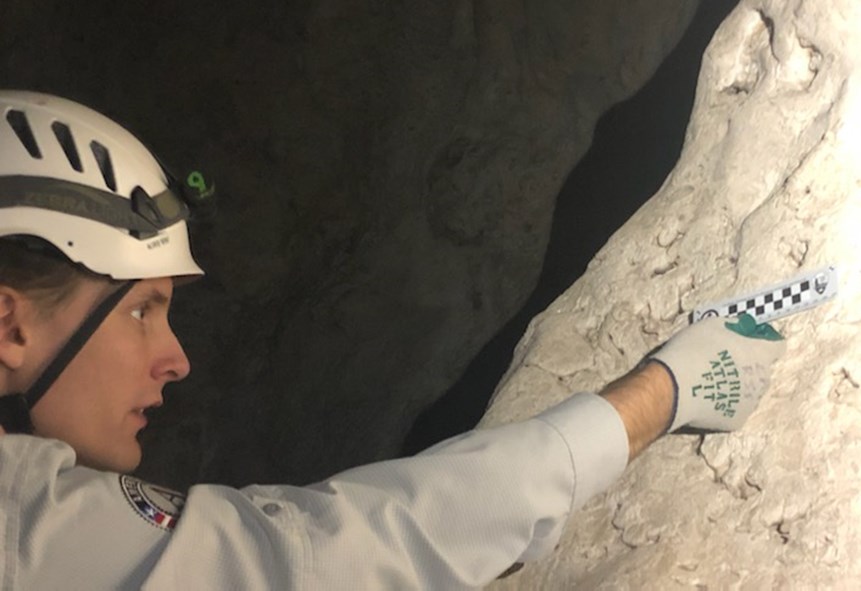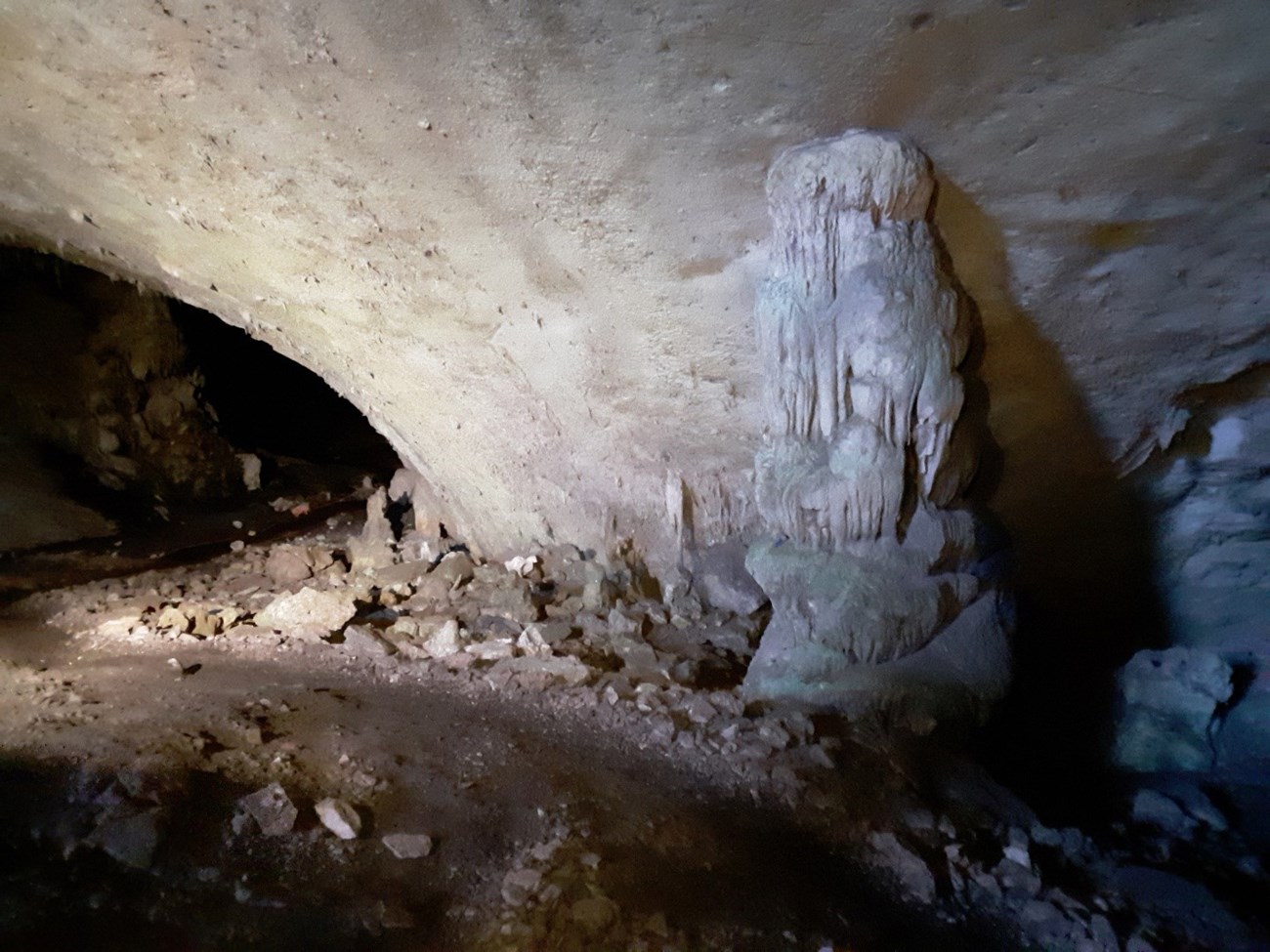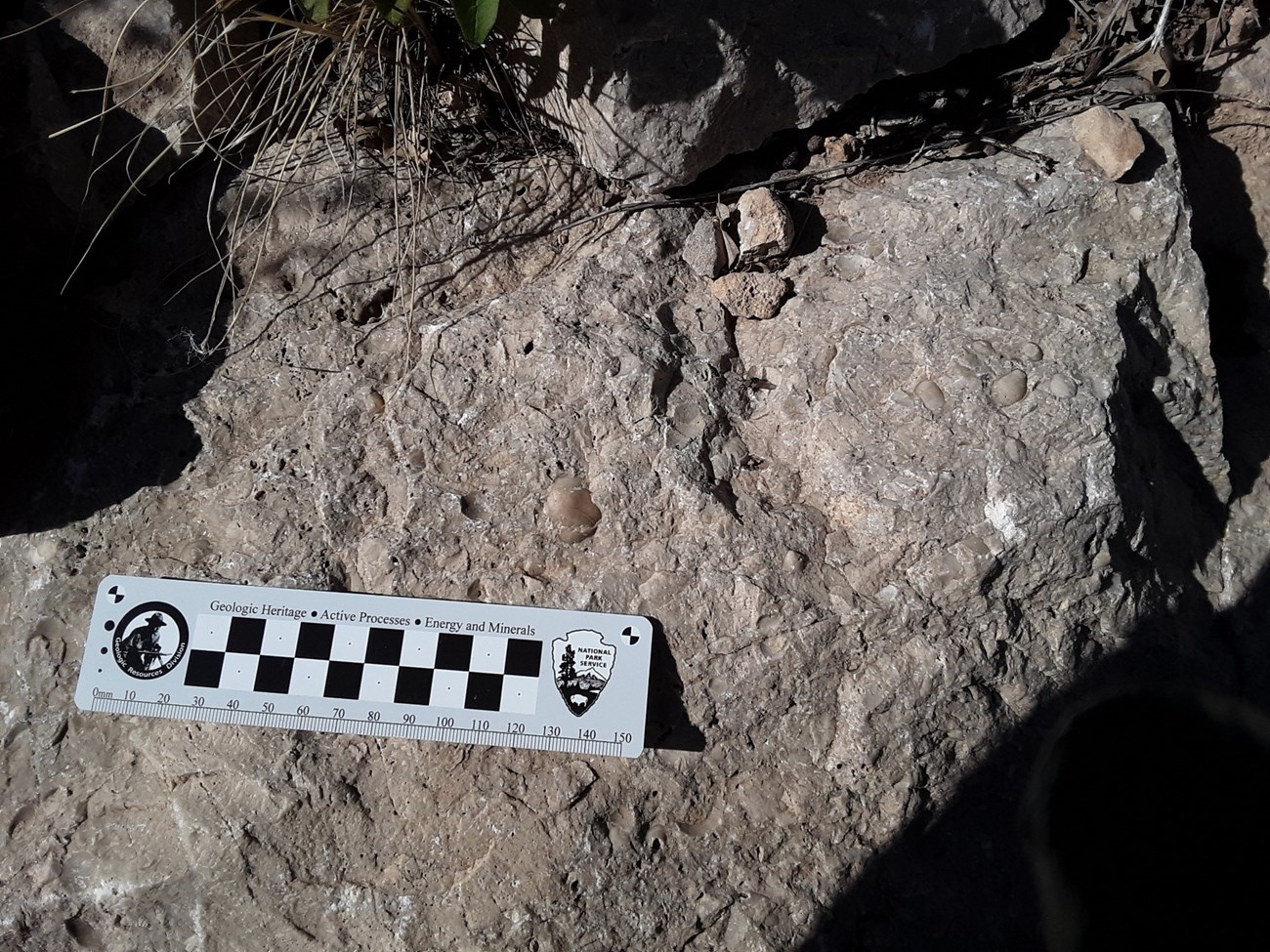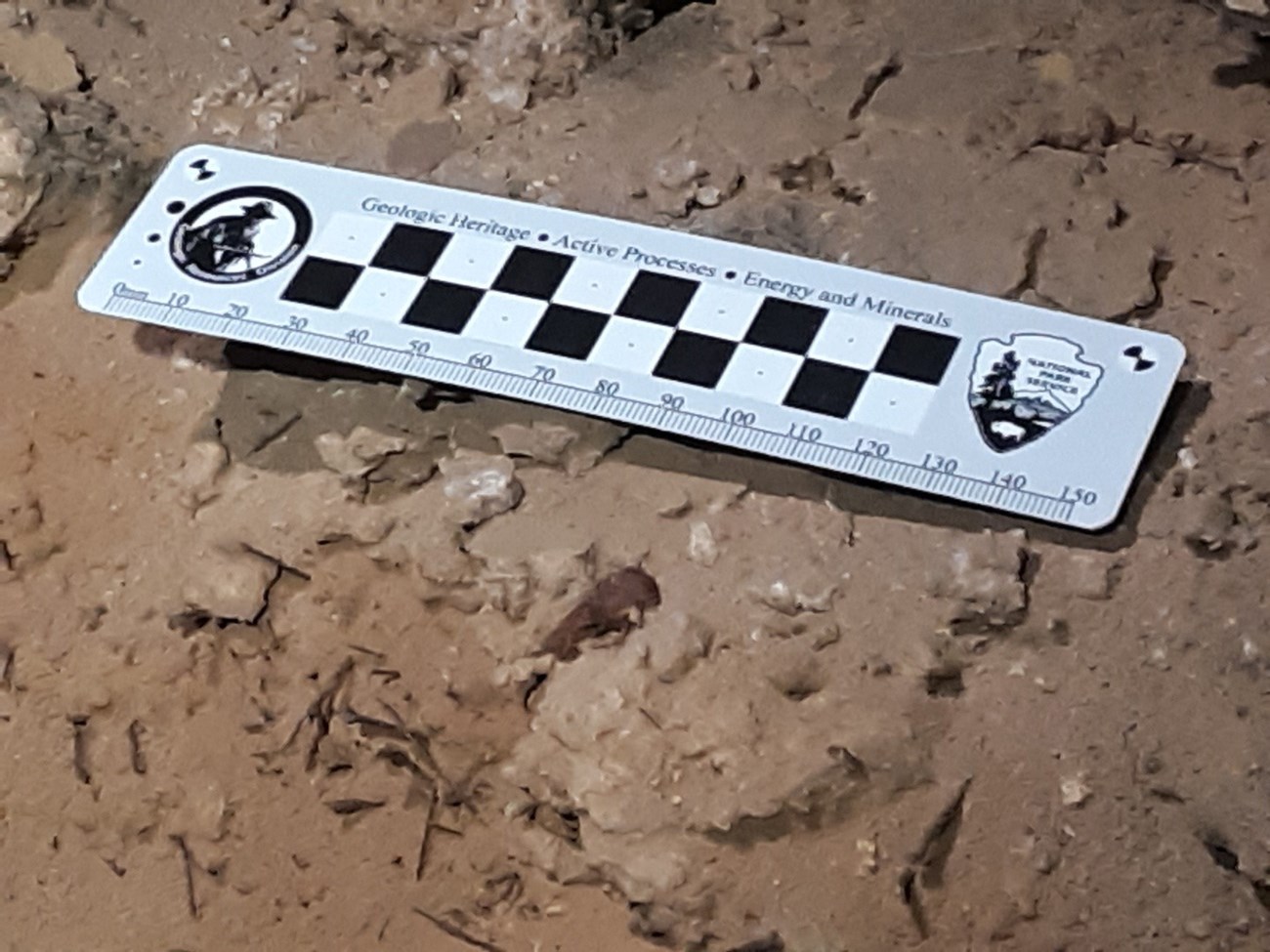Part of a series of articles titled Park Paleontology News - Vol. 12, No. 1, Spring 2020.
Article
An Inventory of Fossils at Carlsbad Caverns National Park

Scott Kottkamp, Paleontology Intern
Carlsbad Caverns National Park, New Mexico

NPS photo.
During the fall and winter of 2019, I was recruited as a paleontology intern to help coordinate the first comprehensive paleontological resource inventory for Carlsbad Caverns National Park. This project involved collaboration between the park staff, the National Park Service Paleontology Program and the New Mexico Museum of Natural History and Science. The focus of the inventory primarily involved the compilation of baseline data documenting the scope, significance, distribution and management issues associated with park fossils. These inventories are useful for informing resource management decisions and are foundational prerequisites for the creation of full paleontological resource management and monitoring plans. It is impossible to set optimal policy and management techniques for a park without first knowing what is located within the park, where resources are located, and what risks are faced by the resources.

NPS photo Scott Kottkamp.
Carlsbad Caverns National Park (CAVE) is extensively fossiliferous; the entire park is situated in, and its namesake caverns are formed within, the remains of a middle Permian age reef and shelf complex. Furthermore, many of the caves contain Pleistocene- and Holocene-age terrestrial remains, with some bat bones in Slaughter Canyon Cave likely being more than half a million years old. Despite the abundance of fossils, a lengthy history of paleontological research, and the paleoecological importance of the paleontological resources within CAVE, no baseline inventory had ever been done at the park. Management activity for fossils was largely folded into more general cave management, such as how monitoring activity largely coincided with cave surveys. An inventory of fossil taxa, localities, conditions, and programs/policies was needed to provide resource managers a summary of the scope, significance, distribution, and management issues associated with fossil resources present within CAVE.

NPS photo.
My role in assembling the CAVE Paleontological Resource Inventory Report was that of lead author. I did the majority of the research regarding paleontological resources at CAVE, wrote initial drafts of most of the sections of the paper, revised those drafts according to feedback by coauthors and experts, and assembled the faunal lists. My work on the project began on October 22nd, 2019. In general, before writing each section, in an order determined by consensus among the authors, I would spend several days researching the subject matter. I would then write a draft, including citations to the sources I used for information, and submit that draft to coauthors or approved outside experts for review. Other duties that I performed included collecting photographs of fossils in-situ and discussing recommendations for future paleontological resource management with CAVE staff.
The CAVE inventory records 15 non-cave Permian localities, 5 non-cave Pleistocene/Holocene localities, and 44 caves containing documented paleontological resources from either time period. Some of these caves contain several localities; Lechuguilla Cave, for example, has 891 fossil localities and counting. These localities are not a comprehensive list of those potentially within CAVE; it is likely that more thorough surveys will reveal fossils in nearly all caves within the park and throughout the surface of the park. 209 invertebrate fossil taxa were documented from within the park, as well as 94 Pleistocene/Holocene vertebrate taxa and a small number of microbes, ichnofossils, and plants. Permian vertebrates and Quaternary invertebrates are known from localities near CAVE of analogous age and depositional environment, but not from within the park. The list of invertebrates is based on current published data and analysis, and it is highly likely that further investigation of Permian invertebrates at CAVE will identify hundreds of additional species within the park. Likewise, the micro-fossil assemblages from the Pleistocene and Holocene have not been researched in-depth, and doing so is highly recommended in order to flesh out the herpetological and small avian constituents.

NPS photo by Scott Kottkamp.
CAVE is somewhat unique among national parks in that it records two time periods that are temporally, depositionally, ecologically, and environmentally distinct; a marine Permian reef-complex mostly represented by invertebrates and a variety of terrestrial Quaternary environs represented by vertebrates. Despite the differences between the two time periods preserved at CAVE, both share an intriguing and critically important similarity in that both record a time of major ecological change likely driven by climate change. The rocks at CAVE date from just before the Guadalupian mass extinction 260 mya, an event separated from the end-Permian mass extinction by ten million years. There is evidence in the rock record that the mesophotic reef shallowed out over time, corresponding to the change from a diverse macro-fauna and a micro-framework made up of the red algae Archaeolithoporella, the problematic organism Tubiphytes, and colonial bryozoans, to near-dominance by the sponge Gigantospongia among the macro-fauna, to a stage where only Archaeolithoporella/Tubiphytes and microbes made up the reef (Weidlich and Fagerstrom 1998). This shallowing corresponded with an increasingly arid climate, which may have cut off the basin from the ocean and led to the slow death of the reef by sedimentation and hypersalinity (Hill 1996; Kerans and Kempter 2002). Meanwhile, the Pleistocene assemblage reflects a montane and/or mesic environment, ranging from forests to lush grasslands, as evidenced by the presence of taxa such as: Harrington’s Mountain Goat (Oreamnos harringtoni) (Jass et al. 2000); American Water Shrew (Sorex palustris); and the Shrub Ox (Euceratherium collinum) (Logan 1981; Morgan and Lucas 2006). However, as the fossil record transitions into the Holocene the more water-dependent taxa go extinct or are extirpated to refugia in the north (Murray 1957; Harris 1985). The remaining, and Holocene-exclusive, taxa come to more closely resemble the modern xeric-adapted fauna of CAVE. These mass extinctions and ecological turnovers are a critical aspect of CAVE’s paleontological resources, holding importance to interpretation and future research at a time where climate change and invasive species threaten the Chihuahuan Desert.

NPS photo by Scott Kottkamp.
The largest known species of Permian sponge, Gigantospongia discoforma, was discovered just outside of the boundaries of CAVE and can be found within the park as well. This sponge was 2.5 m wide, but only 8-20 mm thick (Rigby and Senowbari-Daryan, 1996). It is currently hypothesized that these sponges grew horizontally outward from the wall of the slope into the marine water (Wood et al. 1994; Wood 1999). The large, platy Gigantospongia discoforma then sheltered fissures and crevices in the rock, where cryptobiotas of smaller sponges, bryozoans, and other organisms flourished. These cryptobiotas seem to have been some of the most diverse habitats within the reef, at least in terms of non-microorganisms. An alternative model for Gigantospongia is that it grew upright in a blade-like manner, and the cryptobiotas were formed by a debris pile of fallen sponge blades and other reef talus (Rigby et al. 1998).
One notable feature of CAVE’s Pleistocene/Holocene record is the near-absence of woodrat middens, buildups of woodrat urine, debris, and nesting materials over subsequent generations of the animals. Large, stable middens are critical paleoecological records because they preserve a record of plant life in the area immediately surrounding the midden, and can be tens of thousands of years old (Borrelli and Holmgren 2016; Balmaki and Wigand 2019). However, despite woodrat fossils being common at CAVE, and caves often being excellent locations for preserving middens (Dézerald et al. 2019), middens are very rare at CAVE. The inventory only found one midden from within a cave or karst feature at the park, and it is small, recent in age, and unstable as it occasionally hydrates and flows. The absence of old middens despite the presence of woodrats within the park throughout the Quaternary is likely because of the large rooms characteristic of Carlsbad Caverns. The air in these caverns is very humid and this causes the hygroscopic urine binding the midden to hydrate and flow away, in turn allowing the plant material to rot (Betancourt, personal communication, November 2019). However, it is possible that some of the smaller karst features at CAVE could contain paleoecologically useful middens.
The inventory revealed a major data gap at CAVE, especially in terms of its backcountry caves and its Permian taxa. Because of the relevance CAVE’s paleoclimate and paleoecology have to modern concerns, the inventory has indicated a need to resolve this data gap through future paleontological research at CAVE. The inventory will serve as a core foundation upon which to develop future paleontological resource management at CAVE, but further exploration of CAVE’s potential paleontological resources is essential in order to properly assess best policies.
References Cited
- Balmaki, B., and P. E. Wigand. 2019. Reconstruction of the Late Pleistocene to Late Holocene vegetation transition using packrat midden and pollen evidence from the Central Mojave Desert. Acta Botanica Brasilica 33(3):539–547.
- Borrelli, M. P., and C. A. Holmgren. 2016. Dietary modifications of packrats in response to changing plant communities: Evidence from fossil plant cuticles spanning >55,000 years in Sonoran Desert packrat middens. Journal of Arid Environments 135:1–8.
- Dézerald, O., C. Latorre, J. L. Betancourt, G. A. B. Vera, and A. L. González. 2019. Ecological fidelity and spatiotemporal resolution of arthropod death assemblages from rodent middens in the central Atacama Desert (northern Chile). Quaternary Science Reviews 210:15–25.
- Harris, A. H. 1985. Late Pleistocene vertebrate paleoecology of the West. University of Texas Press, Austin, Texas.
- Hill, C. A. 1996. Geology of the Delaware Basin, Guadalupe, Apache, and Glass Mountains New Mexico and West Texas. West Texas Geological Society Bulletin 36(1):5–7.
- Jass, C. N., J. I. Mead, and L. E. Logan. 2000. Harrington's extinct mountain goat (Oreamnos harringtoni Stock 1936) from Muskox Cave, New Mexico. Texas Journal of Science 52:121–132.
- Kerans, C., and K. Kempter. 2002. Hierarchical stratigraphic analysis of a carbonate platform, Permian of the Guadalupe Mountains. AAPG Datapages Discovery Series 5.
- Logan, L. E. 1981. The mammalian fossils of Muskox Cave, Eddy County, New Mexico. Proceedings of the Eighth International Congress of Speleology 1:159–160.
- Morgan, G. S., and S. G. Lucas. 2006. Pleistocene vertebrates from southeastern New Mexico. Pages 317–336 in B. S. Brister, P. W. Bauer, and A. S. Read, editors. Caves and karst of southeastern New Mexico. New Mexico Geological Society, Socorro, New Mexico. Guidebook, 57th Field Conference.
- Murray, K. F. 1957. Pleistocene climate and the fauna of Burnet Cave, New Mexico. Ecology 38:129–132.
- Rigby, J. K., and B. Senowbari-Daryan. 1996. Gigantospongia, new genus, the largest known Permian sponge, Capitan Limestone, Guadalupe Mountains, New Mexico. Journal of Paleontology 70(3):347–355.
- Rigby, J. K., B. Senowbari-Daryan, and H. Liu. 1998. Sponges of the Permian Upper Capitan Limestone, Guadalupe Mountains, New Mexico and Texas. Brigham Young University Geology Studies 43:19–117.
- Weidlich, O., and J. A. Fagerstrom. 1998. Evolution of the Upper Capitan-Massive (Permian), Guadalupe Mountains, New Mexico. Brigham Young University Geology Studies 43:167–188.
- Wood, R. 1999. Paleoecology of the Capitan reef. Pages 129–137 in A. H. Saller, P. M. Harris, B. L. Kirkland, and S. J. Mazzullo, editors. Geologic framework of the Capitan Reef. SEPM, Tulsa, Oklahoma. Special Publication 65.
- Wood, R., J. A. D. Dickson, and B. Kirkland-George. 1994. Turning the Capitan Reef upside down: a new appraisal of the ecology of the Permian Capitan Reef, Guadalupe Mountains, Texas and New Mexico. Palaios 9:422–427.
Last updated: April 20, 2021
